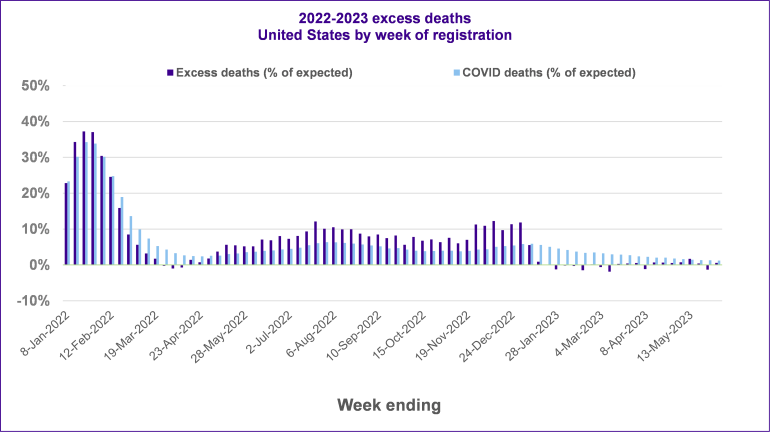Question:
How are US excess deaths progressing in 2023?
Answer:
US excess deaths have dropped considerably since the beginning of 2023; after rounding, the period of January – May 2023 saw 0% excess deaths. While COVID deaths continue to persist, reductions in other causes of death across the US population have offset the COVID-related increases. The chart below shows the percentage increase or decrease in weekly deaths in the US compared to the number of deaths expected for that week for the 2022-2023 period. As you can see, expected deaths have dropped to very low levels since the beginning of 2023.
Any analysis of excess deaths is dependent on the definition used for the “expected” number of deaths. For this analysis we have made a number of simplifying assumptions and assumed the expected number of deaths after 2019 has followed the same linear trend as deaths in the 2015-2019 period – namely that they increase by around 1.3% each year. (Deaths in the US are expected to increase each year in the near future due to a growing and aging population, this is partially offset by expected annual improvements in mortality rates).

Sources: CDC weekly death data available as at June 28, 2023. Expected deaths show the continuation of the linear trend in 2015-2019 deaths
Key takeaways
- Excess deaths seem to have fallen away considerably since the start of 2023
- The last major wave of the COVID-19 pandemic was the Omicron wave that occurred in Jan-Feb 2022. Since then, excess deaths have reduced considerably.
- The figures presented are for the general US population. There are still significant regional variations in excess death patterns, with the Northeast and Midwest seeing relatively lower levels of excess death, and the West seeing relatively higher levels.
The key questions are:
- Will the lower levels of excess death continue through the rest of 2023?
- Given that DB pensioners usually see greater rates of mortality improvements than the general population, will excess deaths actually be lower than 0% for this population?
- Did we enter the much anticipated “new normal” period of mortality data after the end of the Omicron wave in 2022?
- How should we allow for this emerging picture when modeling future mortality assumptions?





